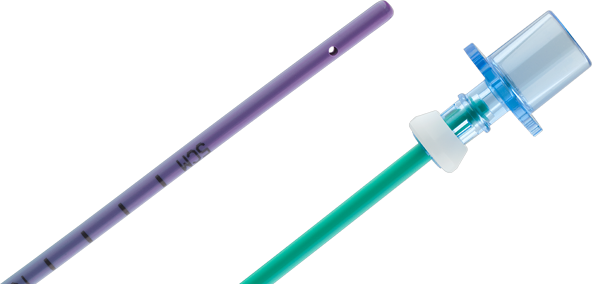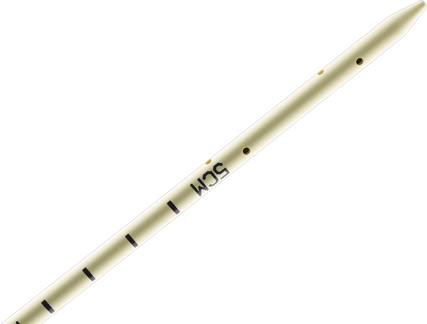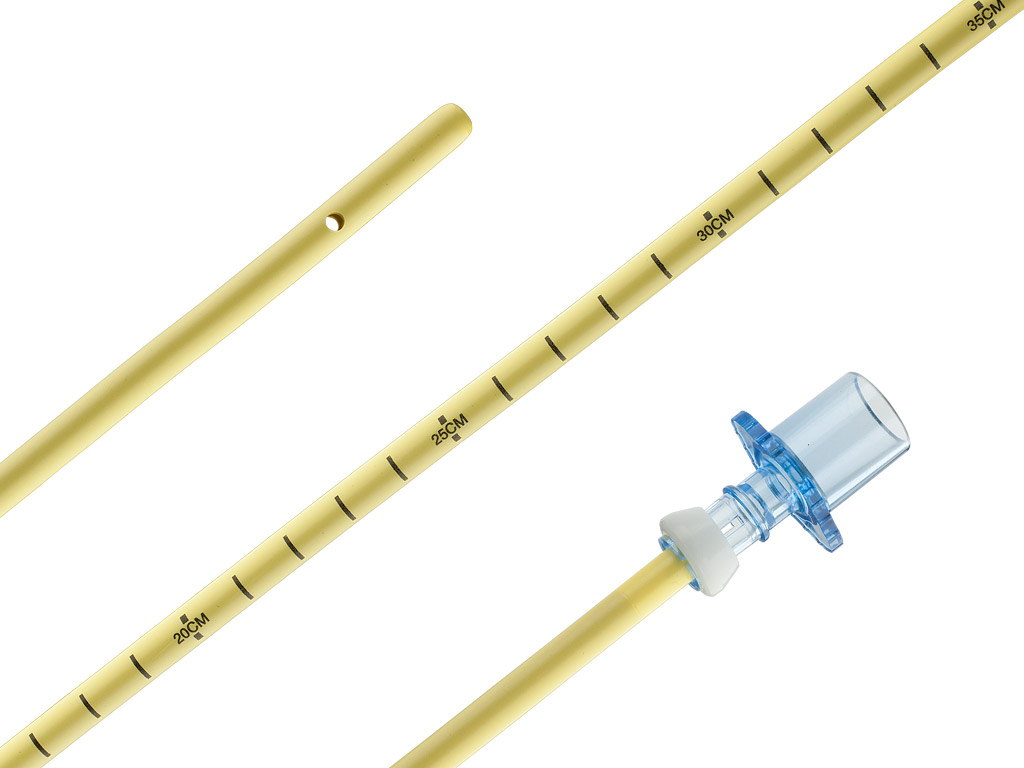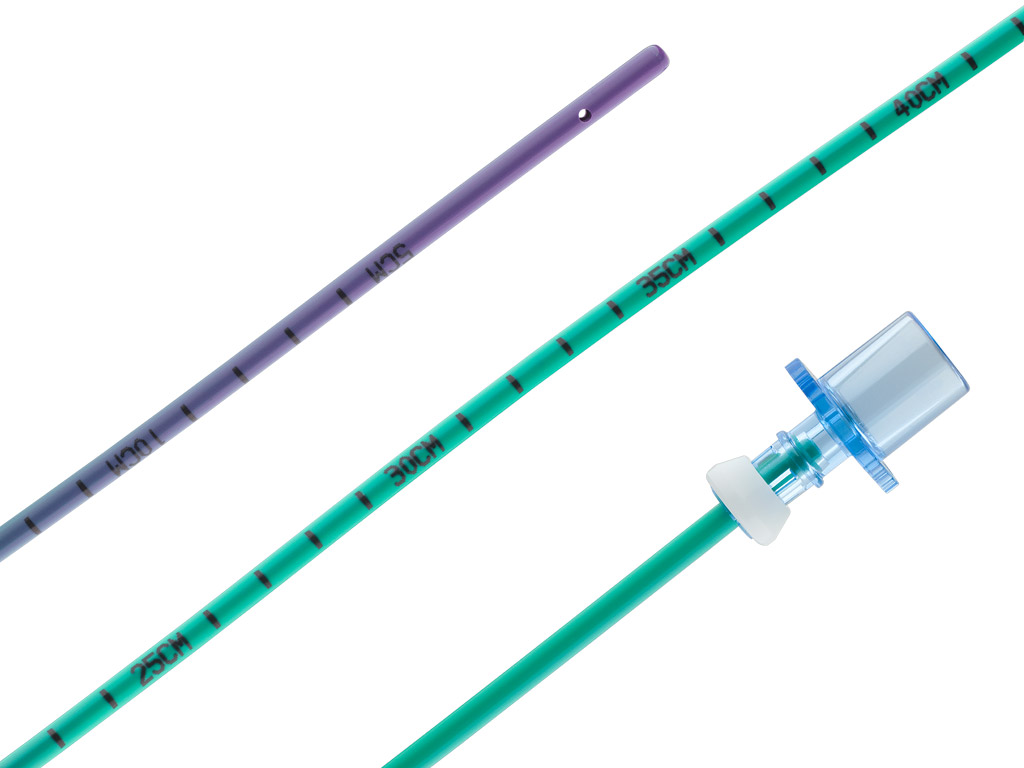Cook® Airway Exchange Catheter
The Cook Airway Exchange Catheter is intended for endotracheal tube exchange in adult and pediatric patients.1
Features & Benefits
- The blunt tip of the radiopaque catheter is designed to be atraumatic
to internal structures. - The lumen and distal sideports are designed to deliver oxygen.
- The centimeter markings facilitate alignment with endotracheal tubes.
- The removable Rapi-Fit® Adapters permit oxygen delivery during an exchange procedure, if necessary.1
- The 8 French catheter is recommended for placement of an endotracheal tube with an inner diameter of 3 mm or larger. When used for high-pressure oxygenation with a Luer lock connector, the 8 French catheter is recommended for patients older than 1 month of age. The 11 French catheter is recommended for placement of an endotracheal tube with an inner diameter of 4 mm or larger. When used for high-pressure oxygenation with a Luer lock connector, the 11 French catheter is recommended for patients older than 2 years of age. The 14 French catheter is recommended for placement of an endotracheal tube with an inner diameter of 5 mm or larger. When used for high-pressure oxygenation with a Luer lock connector, the 14 French catheter is recommended for patients older than 2 years of age. The 19 French catheter is recommended for placement of an endotracheal tube with an inner diameter of 7 mm or larger. When used for high-pressure oxygenation with a Luer lock connector, the 19 French catheter is recommended for patients older than 12 years of age.
For complete instructions, age-specific recommendations, contraindications, warnings, and precautions, see the Instructions for Use included with each product.
See full image.

Find ordering information and other resources for this product at cookmedical.com.
ESSENTIAL PRESCRIBING INFORMATION
CAUTION: U.S. federal law restricts this device to sale by or on the order of a physician (or properly licensed practitioner).
INTENDED USE: The Cook Airway Exchange Catheter is intended for endotracheal tube exchange in adult and pediatric patients. The 8 French catheter is recommended for placement of an endotracheal tube with an inner diameter of 3 mm or larger. When used for high-pressure oxygenation with a Luer Lock connector, the 8 French catheter is recommended for patients older than 1 month of age. The 11 French catheter is recommended for placement of an endotracheal tube with an inner diameter of 4 mm or larger. When used for high-pressure oxygenation with a Luer Lock connector, the 11 French catheter is recommended for patients older than 2 years of age. The 14 French catheter is recommended for placement of an endotracheal tube with an inner diameter of 5 mm or larger. When used for high-pressure oxygenation with a Luer Lock connector, the 14 French catheter is recommended for patients older than 2 years of age. The 19 French catheter is recommended for placement of an endotracheal tube with an inner diameter of 7 mm or larger. When used for high-pressure oxygenation with a Luer Lock connector, the 19 French catheter is recommended for patients older than 12 years of age.
CONTRAINDICATIONS: None known
WARNINGS: Possible allergic reactions (e.g., to butyl rubber) should be considered. • Advancing the catheter beyond the carina may introduce additional procedural risks and trauma. • Attention should be paid to the insertion depth of a Cook Airway Exchange Catheter (CAE) into the patient’s airway and correct tracheal position of replacement endotracheal tube (ETT). Markers on the CAE refer to distance from the distal tip of catheter. • Take care to avoid injuring the epiglottis, glottis, trachea, bronchi, or lung parenchyma, and to avoid perforating the sinus pyriformis while using this device. • Ensure proper sizing of the CAE within an ETT (including double-lumen ETT). • To avoid barotrauma, ensure that the tip of the CAE is always above the carina, preferably 2-3 cm. • Use of the Rapi-Fit adapter for oxygenation may be associated with a risk of barotrauma. • Use of an oxygen source should be considered only if the patient has sufficient egression of the insufflated gas volume. • Oxygen insufflation may not be appropriate for all patient subgroups and with all products. Please refer to the Catheter Oxygenation Table for product and patient subgroup details. • If a high-pressure oxygen source is used for insufflation (e.g., jet ventilator), begin at a lower pressure (i.e., 5 psi) and work up gradually. Rising chest wall, pulse oximetry, and oral air flow should be carefully monitored. • Ensure that the Rapi-Fit Adapter is securely connected to the CAE prior to oxygen delivery. Failure to properly secure the adapter to the CAE may result in hypoxia and serious adverse events. • Using high-pressure oxygenation with a Luer lock connector in the infant patient subpopulation (> 1 month to 2 years) has only been evaluated with the 8 French catheter; using larger catheters with this subpopulation is not recommended. • For the 19 French catheter, high-pressure oxygenation with a Luer lock connector should only be used in patients older than 12 years of age. If used in patients 12 years old or younger, the maximum airway pressure may be higher than 28 cm H2O.
PRECAUTIONS: The product is intended for use by clinicians trained and experienced in airway management techniques. Standard techniques for placement and exchange of ETTs should be employed. • This product is not intended for intravascular use. • Lubricate the catheter and ETT (with a sterile lubricant) before use. • This device is not recommended for definitive, long-term airway management.
POTENTIAL ADVERSE EVENTS: Barotrauma • Pneumothorax • Hypoxia • Perforation of the trachea, bronchi, or lung parenchyma • Catheter migration • Failed endotracheal tube placement
See package insert for full product information.
AB_C_T_CAE2_REV0
Cook® Airway Exchange Catheter – Extra-Firm with Soft Tip
The Cook Airway Exchange Catheter – Extra Firm with Soft Tip is intended for endotracheal tube exchange in adult and pediatric patients.1
Features & Benefits
- The blunt, soft, and flexible tip of the catheter is designed to be atraumatic to internal structures.
- The distal section of the catheter is flexible.
- The extra-firm catheter facilitates the exchange of double-lumen shaft tubes.
- The lumen and distal sideports are designed to deliver oxygen.
- The centimeter markings facilitate alignment with endotracheal tubes.
- The removable Rapi-Fit® Adapters permit oxygen delivery during an exchange procedure, if necessary.1
- The 11 French catheter is recommended for placement of an endotracheal tube with an inner diameter of 4 mm or larger. When used for high-pressure oxygenation with a Luer lock connector, the 11 French catheter is recommended for patients older than 2 years of age. The 14 French catheter is recommended for placement of an endotracheal tube with an inner diameter of 5 mm or larger. When used for high-pressure oxygenation with a Luer lock connector, the 14 French catheter is recommended for patients older than 2 years of age.
For complete instructions, age-specific recommendations, contraindications, warnings, and precautions, see the Instructions for Use included with each product.
See full image.

Find ordering information and other resources for this product at cookmedical.com.
ESSENTIAL PRESCRIBING INFORMATION
CAUTION: U.S. federal law restricts this device to sale by or on the order of a physician (or properly licensed practitioner).
INTENDED USE: The Cook Airway Exchange Catheter is intended for endotracheal tube exchange in adult and pediatric patients. The 8 French catheter is recommended for placement of an endotracheal tube with an inner diameter of 3 mm or larger. When used for high-pressure oxygenation with a Luer Lock connector, the 8 French catheter is recommended for patients older than 1 month of age. The 11 French catheter is recommended for placement of an endotracheal tube with an inner diameter of 4 mm or larger. When used for high-pressure oxygenation with a Luer Lock connector, the 11 French catheter is recommended for patients older than 2 years of age. The 14 French catheter is recommended for placement of an endotracheal tube with an inner diameter of 5 mm or larger. When used for high-pressure oxygenation with a Luer Lock connector, the 14 French catheter is recommended for patients older than 2 years of age. The 19 French catheter is recommended for placement of an endotracheal tube with an inner diameter of 7 mm or larger. When used for high-pressure oxygenation with a Luer Lock connector, the 19 French catheter is recommended for patients older than 12 years of age.
CONTRAINDICATIONS: None known
WARNINGS: Possible allergic reactions (e.g., to butyl rubber) should be considered. • Advancing the catheter beyond the carina may introduce additional procedural risks and trauma. • Attention should be paid to the insertion depth of a Cook Airway Exchange Catheter (CAE) into the patient’s airway and correct tracheal position of replacement endotracheal tube (ETT). Markers on the CAE refer to distance from the distal tip of catheter. • Take care to avoid injuring the epiglottis, glottis, trachea, bronchi, or lung parenchyma, and to avoid perforating the sinus pyriformis while using this device. • Ensure proper sizing of the CAE within an ETT (including double-lumen ETT). • To avoid barotrauma, ensure that the tip of the CAE is always above the carina, preferably 2-3 cm. • Use of the Rapi-Fit adapter for oxygenation may be associated with a risk of barotrauma. • Use of an oxygen source should be considered only if the patient has sufficient egression of the insufflated gas volume. • Oxygen insufflation may not be appropriate for all patient subgroups and with all products. Please refer to the Catheter Oxygenation Table for product and patient subgroup details. • If a high-pressure oxygen source is used for insufflation (e.g., jet ventilator), begin at a lower pressure (i.e., 5 psi) and work up gradually. Rising chest wall, pulse oximetry, and oral air flow should be carefully monitored. • Ensure that the Rapi-Fit Adapter is securely connected to the CAE prior to oxygen delivery. Failure to properly secure the adapter to the CAE may result in hypoxia and serious adverse events. • Using high-pressure oxygenation with a Luer lock connector in the infant patient subpopulation (> 1 month to 2 years) has only been evaluated with the 8 French catheter; using larger catheters with this subpopulation is not recommended. • For the 19 French catheter, high-pressure oxygenation with a Luer lock connector should only be used in patients older than 12 years of age. If used in patients 12 years old or younger, the maximum airway pressure may be higher than 28 cm H2O.
PRECAUTIONS: The product is intended for use by clinicians trained and experienced in airway management techniques. Standard techniques for placement and exchange of ETTs should be employed. • This product is not intended for intravascular use. • Lubricate the catheter and ETT (with a sterile lubricant) before use. • This device is not recommended for definitive, long-term airway management.
POTENTIAL ADVERSE EVENTS: Barotrauma • Pneumothorax • Hypoxia • Perforation of the trachea, bronchi, or lung parenchyma • Catheter migration • Failed endotracheal tube placement
See package insert for full product information.
AB_C_T_CAE2_REV0
Arndt Airway Exchange Catheter Set
The Arndt Airway Exchange Catheter Set is intended for exchange of a supraglottic airway device (SAD) to an endotracheal tube (ETT) under bronchoscopic assistance, and for ETT exchange in adult and pediatric patients.
The product may be used for emergency, urgent, and elective airway management.1
Features & Benefits
- Use of a bronchoscope provides visualization to facilitate navigation through the patient’s anatomy.
- The wire guide can be inserted through the working channel of the bronchoscope, which allows acute angles to be maneuvered.
- The distal sideports facilitate airflow.
- The removable Rapi-Fit® Adapters permit the use of an oxygen source during an exchange procedure, if necessary.1
- The 14 French catheter is recommended for placement of an endotracheal tube or a supraglottic airway device with an inner diameter of 5 mm or larger. When used for high-pressure oxygenation with a Luer lock connector, the 14 French catheter is recommended for patients older than 12 years of age.
For complete instructions, age-specific recommendations, contraindications, warnings, and precautions, see the Instructions for Use included with each product.
See full image.

Find ordering information and other resources for this product at cookmedical.com.
ESSENTIAL PRESCRIBING INFORMATION
CAUTION: U.S. federal law restricts this device to sale by or on the order of a physician (or properly licensed practitioner).
INTENDED USE: The Arndt Airway Exchange Catheter Set is intended for exchange of a supraglottic airway device (SAD) to an endotracheal tube (ETT) under bronchoscopic assistance, and for ETT exchange in adult and pediatric patients. The product may be used for emergency, urgent, and elective airway management. The 14 French catheter is recommended for placement of an endotracheal tube or a supraglottic airway device with an inner diameter of 5 mm or larger. When used for high-pressure oxygenation with a Luer lock connector, the 14 French catheter is recommended for patients older than 12 years of age.
CONTRAINDICATIONS: None known
WARNINGS: Advancing the catheter beyond the carina may introduce additional procedural risks and trauma. • Attention should be paid to the insertion depth of the Arndt Airway Exchange catheter (AAE) into the patient’s airway and correct tracheal position of replacement endotracheal tube (ETT). Markers on the AAE catheter refer to distance from the distal tip of catheter. • Take care to avoid injuring the epiglottis, glottis, trachea, bronchi, or lung parenchyma, and to avoid perforating the sinus pyriformis while using this device. • Ensure proper sizing of the AAE within the SAD or ETT. • To avoid barotrauma, ensure that the tip of the exchange catheter is always above the carina, preferably 2-3 cm. • Use of the Rapi-Fit adapter for oxygenation may be associated with a risk of barotrauma. • Use of an oxygen source should be considered only if the patient has sufficient egression of the insufflated gas volume. • If a high-pressure oxygen source is used for insufflation (e.g., jet ventilator), begin at a lower pressure (i.e., 5 psi) and work up gradually. Rising chest wall, pulse oximetry, and oral air flow should be carefully monitored. • Ensure that the Rapi-Fit Adapter is securely connected to the AAE prior to oxygen delivery. Failure to properly secure the adapter to the AAE may result in hypoxia and serious adverse events. • High-pressure oxygenation with a Luer lock connector should only be used in patients older than 12 years of age. If used in patients 12 years old or younger, the maximum airway pressure may be higher than 28 cm H2O.
PRECAUTIONS: This product is intended for use by clinicians trained and experienced in airway management techniques. Standard techniques for placement and exchange of SADs or ETTs should be employed. • This product is not intended for intravascular use. • This product should not be used in replacement of SADs or ETTs whose inner diameter is smaller than 5 mm. • The use of capnography is highly recommended to confirm intubation. • A pulse oximeter is recommended during the use of this device. • It is recommended that a sterile lubricant or water be applied to the AAE, bronchoscope, and new SAD or ETT prior to their introduction into the patient. • When using an SAD, ensure the cuff is properly inflated (if applicable) and breath sounds are present. • Ensure that wire guide position is maintained during placement of the AAE. • Patients with airway injuries may have significant spinal cord injury. When possible, the cervical spine should be immobilized before beginning the procedure. • This device is not recommended for definitive, long-term airway management. • The potential effects of phthalates on pregnant/nursing women or children have not been fully characterized and there may be concern for reproductive and developmental effects.
POTENTIAL ADVERSE EVENTS: • Barotrauma • Pneumothorax • Hypoxia • Perforation of the trachea, bronchi, or lung parenchyma • Injury to the epiglottis • Airway bleeding • Catheter dislodgment or migration • Failed endotracheal tube placement
See package insert for full product information.
AB_C_T_ABE2_REV0


